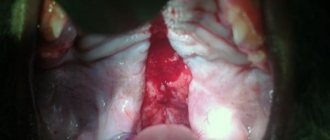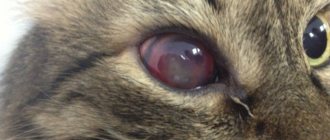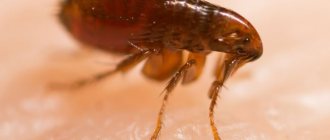10853Administration
1
Almost every owner who has cats has encountered a problem - the animal begins to vigorously scratch its ears, sometimes even to the point of bleeding. The most common reasons why a cat's ears itch are given in this article.
Ear scratching is a red flag that may indicate that your pet is sick. To avoid such problems, you need to regularly examine the animal to assess its health. Failure to promptly treat ear diseases and infections can cause your cat to develop serious hearing problems for life, including complete deafness.
© shutterstock
Itching caused by helminths
There are a large number of varieties of parasitic worms that take up residence in a cat’s body. They can be:
- round;
- flat;
- tape.
Usually at the very beginning of infection it is difficult to consider any of its symptoms, but after a while the animal:
- loses appetite and activity;
- becomes restless;
- Constantly licks and itches.
Worms found in the intestines are considered almost harmless.
Difficulties with your pet’s health arise when there are too many helminths and their larvae begin to migrate.
The movement of worms throughout the animal’s body is accompanied by the following symptoms:
- sudden weight loss, increased fatigue, growth retardation in small pets;
- disheveled wool;
- enlarged liver and icteric staining of visible mucous membranes;
- disruption of the digestive system, expressed in constipation, vomiting, diarrhea;
- appearance of cough;
- discharge from the eyes;
- itching in the anus;
- presence of blood in feces;
- premature birth or miscarriage in cats;
- convulsions and paresis of the limbs.
The cat may not notice the presence of parasites in the body in small quantities. However, their increase will not only exhaust the animal, but will also lead to its death. The harm caused to pets by worms can be completely different:
- eating lymph, tissue and blood;
- release of substances that promote intoxication;
- damage to the mucous membranes by suction cups, leading to internal bleeding.
A pet can become infected with helminths in the following ways:
- eating raw meat or fish (especially river fish);
- flea bites;
- contacts with other animals.
To prevent itching, which causes painful scratching, animal owners need to regularly take a preventive course using anthelmintic medications.
Main reasons
Itching can be caused by both internal and external causes. Most often this is due to the presence of fleas, even if they could not be identified during a visual inspection.
Moreover, irritation on the skin from their bites can persist for 1-1.5 months after the pet has been treated.
The waste products of helminths, as well as the toxins released by them, provoke skin rashes and allergic reactions.
There are other provoking factors that cause an unpleasant symptom. Each of them can be manifested by characteristic itching, but in addition to this, there are other symptoms that make it possible to diagnose the pathology.
Therefore, it is necessary to consider all possible causes and become familiar with their characteristic features.
Helminths
Parasites have a negative impact not only on the digestive organs, but also contribute to the loss of essential nutrients.
As a result, the cat does not receive enough of the necessary components from food, which leads to increased dryness of the epidermis and the appearance of dandruff. This feature provokes itching. Therefore, the pet tries to lick itself more often and more intensely in order to eliminate the unpleasant symptom.
The waste products of helminths, as well as the toxins released by them, provoke skin rashes and an allergic reaction.
Helminthiasis occurs in both adults and kittens. Infection occurs through flea bites and contact with an infected animal.
Parasites can be transmitted to humans and other pets ; treatment should be carried out on everyone at the same time.
Characteristic features:
- faded, matted fur;
- peeling of the epidermis;
- changes in taste preferences due to digestive failure;
- sour eyes;
- unusual behavior.
For prevention purposes, it is recommended to vaccinate or regularly give special suspensions, which can be purchased at a veterinary pharmacy.
Ringworm
This fungal disease also causes annoying itching in cats. The provoking factor for development is a lowered immune system and an unbalanced diet.
Ringworm causes annoying itching in cats
Infection can occur through contact with a sick street animal, as well as from an owner who brings spores of a pathogenic fungus on his clothes. Lack of treatment can cause the death of your pet.
The danger of ringworm is that it can be transmitted to humans. Therefore, therapy should be started at the first signs to avoid serious complications.
Additional signs:
- the fur falls out in clumps;
- bald patches appear on the body;
- inflamed areas become covered with scales and become inflamed;
- the pet constantly shows anxiety;
- the wool is greasy, matted, without a healthy shine;
- claws become deformed;
- lack of interest in food;
- In place of bald patches, ulcers form.
The general condition of the sick animal is depressed; when licking and scratching the ulcers, the animal may meow pitifully, as this causes pain.
Lice, ticks, fleas and skin parasites
All external parasites not only bite the animal, causing skin irritation, but also leave behind waste products, which provokes an unpleasant symptom.
Why does the cat shake his head and scratch his ears?
As already mentioned, if a cat occasionally scratches its ears, then there is nothing wrong with it; the owner should become concerned if one or more of the following symptoms are observed:
- the cat scratches its ears too often;
- the animal shakes its head violently;
- behind the ears (or in front of the auricle) scratches and bald spots have formed from frequent scratching;
- tactile ears are hotter than the rest of the body;
- when light pressure is applied to the ear, the cat experiences pain;
- the inside of the ears is covered with a dark mass, an unpleasant odor emanates;
- I can hear something squelching in my ear.
The reasons why a cat's ears begin to bother them can be very diverse.
- Many purebred cats, due to the structural features of the auricle (Scottish Fold, Scottish Fold, etc.), have a tendency to develop chronic forms of otitis. Other cat breeds often have a congenital narrow ear canal, which can cause ear diseases and their transition to a chronic form.
- Excessive wax formation is considered a congenital or acquired feature, which can lead to chronic ear diseases.
- Among the acquired causes that can become the source of the disease are injuries. Even when cleaning your ears, it is advisable to act as gently as possible so as not to damage the ear canal and eardrum.
- Also, some ear diseases can appear after bathing an animal if water gets into the ears.
- Separately, it is worth noting the untimely treatment of cats from parasites, as a result of which ear mites can settle in the ears.
The listed reasons can lead to diseases - otitis, otodectosis, sulfur plug. Each of these diseases has its own treatment characteristics, so their correct diagnosis is very important.
What do healthy cat ears look like inside and out?
A healthy animal has ears that are uniformly pink inside, clean, without any dirt or crusts. The skin on their inner surface is absolutely intact, there are no signs of inflammation or ulcers. Normally, they should not emit an unpleasant odor. The outside of the cat's ears should also not have redness or abscesses. The coat on them should be uniform, without bald patches.
Possible reasons
It is normal for a pet to occasionally scratch its ears. A healthy kitten scratches its ear up to 4 times a day. The only cause for concern should be frequent scratching. This could be a sign of a dangerous disease.
The most common reasons for a kitten constantly scratching its ears are:
- Ear scabies. The cause is a tick that parasitizes animals. Penetrates into the ear, where it settles and causes discomfort. The kitten shakes its head and scratches its ear vigorously. The affected area turns red and swelling appears. Antiparasitic drops are used for treatment.
- Notoedrosis is a very dangerous disease. The causative agent is the sarcopid mite. In addition to the ear, it affects the eyes and nose. The affected areas are itchy, and the kitten constantly scratches them. The skin dries out and bursts. Treat with antimicrobial ointments, antibiotics and antiparasitic drugs.
- Otitis - can occur from hypothermia in a kitten. The inner or middle ear is inflamed and there is discharge. The kitten may shake its head or tilt it to the side of the affected ear. Treatment with antibacterial therapy is prescribed by the doctor.
- Foreign body in the ear. If you notice it, try to pull it out yourself. If your attempt is unsuccessful, contact a specialist.
- Ear injuries. For minor wounds, treatment with an antiseptic is indicated.
- Sulfur pollution.
The owner of the animal needs to examine his ward and try to figure out the problem. If the symptoms are caused by a buildup of earwax, this can be easily corrected by performing ear hygiene. In all other cases, it is recommended to contact a veterinary clinic.
The main reasons for scratching the ears
As a rule, ear diseases are accompanied by changes in the surrounding fur. It becomes dull, rolls into lumps, and becomes wet from inflammatory exudate.
Sulfur plugs
It is necessary to regularly check the ears for the presence of dry discharge, and remove accumulations of wax with a tightly rolled cotton or gauze swab (plastic cotton swab). The external auditory canal in cats is wide, so caring for the ears will not be a problem.
Ear mites (otodectosis, or ear scabies)
Ear mites in cats belong to the group of invasive ear diseases.
The disease usually occurs after contact with sick animals (the tick is especially often transmitted from an infected cat to kittens). A small mite attaches to the hairs of the external auditory canal, gnawing through the epidermis. This parasite feeds on blood and lymph. The integrity of the skin is compromised: first there is liquid discharge from the ears, then blood crusts appear.
Mite waste products irritate skin receptors. The ears begin to itch - the animal becomes restless. A secondary infection (viral, bacterial, fungal) is layered onto damaged covering tissues, which can result in suppuration and even sepsis.
Ear mites, like many parasites, are most active in the warm season. Regular examination is the most reliable method for detecting skin parasites.
Diagnosis of otodectosis is made by collecting contents from the ear canal and examining it under a microscope.
Inflammation of the external auditory canal, which can “spread” to the inner ear. Discharge from the ears begins: at first it is liquid and colorless, then it becomes thick and purulent, often with an unpleasant odor. The cat tilts its head to the side of the affected ear. Sometimes damage to the ear canals can be bilateral.
Ear tumors
Polyps and other benign tumors can grow from the tissues of the ear canal, blocking its lumen. More often they occur in young individuals (up to 4 years old). It is important to “catch” and remove the tumor before it becomes malignant and metastasizes. Ear canal cancer is more the prerogative of older cats. But, fortunately, it rarely occurs.
Head and ear injuries
Head injury in a cat. Injury near the ear.
Fights with neighbor cats, falls from heights, and impacts with objects can cause ear damage. Such conditions are easily diagnosed - after external influences, as a rule, the wound is extensive and extends not only to the ears, but also to any area of the head.
Foreign objects
Examination of the cat's ear to look for foreign objects.
While walking, insects, plant particles, and sand can get into your cat's ear. Every time after your pet goes outside, you should inspect its ear canals.
Water got into ears after swimming
After swimming, water could get into the ears. Therefore, veterinarians recommend using special caps while bathing.
The cat is worried and intensively shakes its head from side to side, trying to remove fluid from the ear canal. After the bath, you need to use a cotton swab to “take away” all the water from your ears.
Skin diseases
Allergic or infectious dermatitis, eczema. Dermatitis can be diagnosed by redness and swelling on the skin, which can be seen when the fur is parted. A characteristic sign of eczema is small bursting blisters with light gray contents on a bright red background, which, when opened, form small ulcers.
Diagnosis of ear diseases in cats
Each disease has its own diagnostic method. The owner can determine whether a pet has ticks on his own. To do this, take a cotton swab and run it along the inside of the ear. Then transfer the scraping to a black cloth and examine the contents under a magnifying glass. As a rule, white parasites will be noticeable during such an examination.
In other cases, the diagnosis is carried out by a doctor. An accurate diagnosis is made based on a visual examination of the animal (wounds, scratches, peeling in the ears), smear, x-ray, ultrasound, bacterial culture. It is not always possible to use the latter method due to the lack of equipment in many clinics, but it is the most accurate.
Treatment depends on the specific disease and can be medicinal and surgical (in the presence of tumors).
When should you consult a veterinarian?
The owner can determine some causes of severe itching of the ears on his own. For example, you can see a foreign object stuck in the ear, a hematoma, or a bee sting. Diagnosis of otitis media, ear scabies, and allergies is possible only in a veterinary clinic. To clarify the diagnosis and the degree of development of the disease, the specialist conducts laboratory tests of ear secretions, blood, and analyzes X-ray and ultrasound data. Based on the examination results, the optimal treatment regimen is selected.
Symptomatic treatment
Physiological tremor does not require treatment.
To understand that a cat is shaking its head because it is in pain, it is important to observe it. The following signs should alert you:
- the animal not only shakes its head, but also actively itches (to the point of wounds and abrasions);
- pus or ichor flows from the ears;
- the cat does not lay its head on a certain side;
- the animal's appetite decreases or completely disappears;
- there is a shaky gait, movements are not coordinated;
- the cat meows loudly and pitifully or, on the contrary, becomes lethargic and tries to hide from prying eyes.
In case of pathological jerking of the head, the diagnosis must be made by a doctor. To do this, he will examine the cat's ears and take blood tests. If no external signs of pathology are found, the veterinarian will perform an ultrasound or computed tomography. After making the correct diagnosis, the specialist will prescribe the appropriate treatment:
- For the treatment of otodectosis, antiparasitic ear drops may be sufficient; for the treatment of otitis, antibiotics will have to be used.
- It is also best to entrust the removal of foreign bodies from the ear to a veterinarian. After the procedure, the specialist will treat the ear with antibiotics and prescribe drops that will help avoid infection.
- Antifungal therapy involves treatment with chlorhexedine (rinsing the ears with a solution) and treating the ears with Otibiovin drops. Veterinarians also prescribe internal administration of Ketokenozol. But it must be given to your pet strictly in the dosage recommended by the veterinarian.
- Dermatitis is treated with hydrogen peroxide and treatment with ointments that have astringent properties, for example, 2 percent silver nitrate. Dropping a few drops of novocaine into the ears will help relieve itching.
- If neoplasms occur, the issue of surgery is decided. Most often, the ear and hearing can be preserved when growths and tumors are removed.
- Neurological disorders and failure of one or another organ require specific treatment, which can only be offered by an experienced veterinarian.
- Multiple organ diseases and liver failure require treatment of the underlying disease. When recovery occurs, the tremor will go away.
When to see a doctor
For any cat, scratching its ears is a normal process, which is a hygienic procedure that helps the animal get rid of dirt and foreign bodies. But when it becomes permanent, and the pet experiences great discomfort and anxiety, it is necessary to show it to a doctor. Only by identifying the reasons for this behavior can effective treatment methods be selected.
If a cat has otitis media, measures taken to get rid of ear mites can lead to serious consequences, including complete hearing loss. A visit to the clinic should not be postponed if:
- Ear scratching causes anxiety, causing the cat to shake its head in irritation.
- The animal becomes nervous.
- The cat scratches its ears vigorously more than 10 times a day.
- Small wounds appeared on the surface of the ears.
Detection of one or more of the listed symptoms is a serious reason to visit a doctor.
1.General information
The appearance of any discharge where normally there should not be one is always a symptom, i.e. a sign of pathology, and in all cases this symptom is quite serious. With regard to the hearing organs, vigilance should be maximum, taking into account their location, anatomical complexity, intensity of innervation and blood supply. Any, even mildly symptomatic or latent pathology in this zone is dangerous. There are many cases where the primary problem could be eliminated relatively quickly and simply, provided timely contact with a doctor, but in the absence of medical care, complications turned out to be extremely severe, disabling, and sometimes fatal.
The discharge of liquid or mucopurulent discharge from the ear canal in medicine is called otorrhea. The reasons for this condition are very diverse, but it is certainly necessary to have at least a general idea of them.
A must read! Help with treatment and hospitalization!
How to help your pet
An attentive owner will always notice in time any unwanted changes in the appearance of his pet. A responsible owner should definitely consult a veterinary dermatologist. It must be remembered that only with an accurate diagnosis can adequate treatment be carried out.
Modern veterinary clinics have all the conditions and equipment to carry out diagnostic procedures and issue an error-free medical opinion. The sick cat will be thoroughly examined and the necessary tests will be carried out:
- blood test: general, biochemical;
- a blood test for the presence of immunoglobulins to determine the likelihood of an allergy;
- scraping from the affected area of the skin.
This way, the veterinarian will get a complete picture of your health status and the causes of baldness and prescribe the appropriate treatment.
What you should absolutely not do: if your cat has a bald spot, and the skin in this area is red and inflamed, you should not self-medicate and use various ointments without the recommendation of a veterinarian. You should take the animal to the clinic as soon as possible.
Modern approaches to treating the disease
Before starting treatment, it is necessary to determine exactly why the cat is shaking its head and intensively scratching its ears. The nature of therapy will directly depend on the causes of the disease, its neglect and the individual characteristics of the animal’s body. If the main etiological factor in the occurrence of a pathological condition is an infectious agent, then it is advisable to prescribe antibacterial ear drops for external use with a wide spectrum of action to the animal. Parasitic infections are treated with antiparasitic drugs, and if allergies develop, systemic medications should be used.
In most cases, when a cat scratches its ears excessively, topical treatment is sufficient. Only advanced forms of otitis need to be treated with systemic medications. Surgical treatment is performed on sick cats extremely rarely - when there is a significant narrowing of the lumen of the ear canal, abscess formation, or the need to excise part of the affected tissue due to their necrosis.
Preventive measures
Every responsible and good owner should monitor the health of their four-legged friend. His short list of responsibilities also includes ear care. It is necessary to clean them with some regularity (a couple of times a month), using special cosmetics. After the bathing procedure, free the ears from any water and moisture that has entered there. Avoid contact with sick animals, stray cats and dogs.
The most important thing is not to postpone visits to the doctor when the first symptoms of any disease appear. This will help to heal your furry friend in time and save you from serious consequences.
Preventing Itchy Ears
The very first rule that is strictly followed for any cat is keeping its ears clean. Hygienic procedures must be carried out at least once a week. Since proud, mustachioed individuals really do not like such manipulations with their ears, your pet should be accustomed to this from a young age, that is, from a very early age. Then it will be much easier to clean, examine, and treat your purring pet.
In addition to cleaning the ears, you need to make sure that your cat does not have parasites. To do this, they periodically carry out helminth prevention by giving the cat special medications.
There are also drops, powders, and sprays for external use that are used to treat the withers of cats. Then external parasites will not have the opportunity to settle on your pet and in her ears.
It is also necessary to show it to the doctor if there is any change in the health status of your pet, so that the treatment quickly brings results, and its absence does not cause serious consequences.
Why does my cat shake her head, scratch her ears, and have brown discharge?
If your cat occasionally shakes its head and scratches its ears, there is most likely no cause for concern. However, when the itching becomes constant, this should alert the owner. Gradually, scratches appear on the ears from the claws. If something bothers the cat, it may press its ears, which is also a sign of the development of pathology. The pet’s mood also changes: it becomes nervous due to discomfort.
The reasons for this condition may be different. Itching is caused by fungal, bacterial infections, fleas and many other factors.
When such symptoms appear, you need to pay attention to discharge from the ear canals. The accumulation of a brown mass, the formation of dark scabs, and an unpleasant odor are often symptoms of one of the dangerous diseases, such as otitis media or ear scabies
With otitis media, the inflammatory process caused by fungi or bacteria covers the structures of the inner and middle ear. This group of pathologies often leads to deafness in the absence of timely treatment.
Sticky brown discharge with a specific odor is a typical sign of otodectosis. When affected by ear mites, cats also shake their heads, as when they have inflammation of the inner ear. Only a veterinarian can make an accurate diagnosis based on the results of the examination.
Otodectosis (ear scabies)
Otodectosis is one of the most common pathologies found in cats. It is caused by microscopic mites that live in the ear canal. These parasites damage the epithelial layer in the ear and injure the eardrum, feeding on blood, epithelium, lymph and wax. The main symptoms of ear scabies:
- severe itching in the ears;
- brown discharge;
- scabs and crusts in the ear canal.
Otodectosis
When infected with ear mites, the cat presses its ears, scratches them, tearing the skin into blood. If you do not help your pet, he may develop one of such dangerous diseases as meningitis and otitis media.
Otodectosis should be treated by a veterinarian. Therapy depends on the severity of the pathology. As a rule, acaricidal drugs (killing ticks) are used. In advanced cases - when a bacterial infection is attached - the animal is prescribed tetracycline antibiotics.
Otitis of various etiologies
Otitis media, or ear inflammation, is also common in cats. Diagnosis and treatment of otitis media is always carried out by a veterinarian. The main symptoms of this disease are:
- dirty ears;
- purulent discharge, ichor;
- itching;
- decreased appetite;
- unsteady gait (with damage to the vestibular structures).
Otitis media can be caused by various reasons. Some breeds of cats are more likely to develop otitis due to the structure of their ears, for example Scottish Folds, whose ears are pressed to the head and the auditory canals are narrowed. Among the external factors that cause otitis media are the following:
- fungal or bacterial infections;
- ear injuries resulting from foreign bodies or improper handling;
- parasitic lesions.
Bacterial and fungal otitis develop as a result of the replacement of normal microflora in the auditory canal with a foreign one. Bacteria and fungi that find themselves in a warm and humid environment actively multiply, causing inflammation.
The traumatic form of otitis occurs as a result of damage to the vessels located in the middle or inner part of the ear. Hematomas block the auditory canals, which interferes with the outflow of physiological fluid and creates a favorable environment for the life of pathogenic organisms.
Parasitic otitis is a complication of otodectosis. Mites damage the deep layers of the skin, penetrate deeper and deeper into the ear canals, injure them, resulting in swelling and inflammation.
How to recognize the cause
To do this, you need to know the symptoms of ear diseases in your four-legged friends and start monitoring your cat.
Symptoms:
- excessive attention to the ears is a direct signal of illness;
- the cat rubs its head on absolutely every object in the house, and does this almost constantly;
- in the outer ear the skin becomes sticky;
- periodic shaking of the head and tilting it to one side;
- discharge from the ear of absolutely any consistency and color, with an unpleasant odor;
- if you wrap the ear, you can find black spots, accumulations, scratches, sores, wounds, redness;
- the pet is restless, does not play at all, is nervous, growls. Sometimes he even shows aggression.
Diagnostic methods
When making a diagnosis, the veterinarian examines the animal's ears using an otoscope. If a tick infestation is suspected, a scraping of dark plaque is taken and examined under a microscope. Other diagnostic methods are also used:
- collection of secretions for bacteriological analysis;
- testing for allergic reactions;
- blood test to determine the general condition of the cat’s body;
- cytological examination of the contents of the auricle.
If, after testing, it is not possible to determine the exact cause of the abnormalities, the veterinarian will order an x-ray to rule out the formation of a tumor. In difficult cases, CT and MRI are performed, which can reveal the spread of inflammation to neighboring organs.
What to do, how to help a cat depending on the problem at home
If you discover that your cat has ear problems, you can provide first aid to her at home. When otodectosis or sulfur plug occurs, it is possible to carry out all the treatment on your own.
In the first case, it is enough to buy drops at a pet store and carry out the course according to the instructions of the drug, and in the second, instill saline solution into the ear canal blocked by a plug several times a day for a week.
When treating a hematoma in an animal, the auricle is lubricated with absorbable ointments, such as Troxevasin and Troxerutin. It is unacceptable to try to open a hemorrhage yourself.
In veterinary pharmacies, the seller will always recommend a suitable remedy based on the description of the symptoms and you can help your pet at home.
For dermatitis, drops containing novocaine are instilled into the ears, crusts are removed with a soft swab with hydrogen peroxide, and weeping ulcers are treated with astringent ointments.
Fungal infections require appropriate treatment. Antifungal medications orally, cleaning with swabs and instillation of medicinal drops against fungi.
· first you need to clean the cat’s ear from excess wax and pus with a soft swab with peroxide;
· injections with novocaine are given at the base of the ear;
· instill drops against otitis media;
· give antihistamines orally.
An allergy in a cat can be assumed if the animal shakes its head and its ears are clear. An allergic reaction can occur to new food or household chemicals and is treated the same way as in humans - antihistamines orally and locally. Only the medicine must be selected at a veterinary clinic or pharmacy.
The most effective means against fleas are most often special drops on the withers and regular bathing. Any skin lesions that appear from dirt are afraid of water and good soap or shampoo. If your cat has the opportunity to walk outside every day, you can additionally wear an anti-flea collar and strictly monitor the duration of the active drug.
Treatment
Initially, when a person notices that a cat is actively scratching its ears, it is necessary to lubricate the ear if the cat scratched it. For this, ointments with a healing effect that soothe and relieve inflammation are suitable. The second step is to thoroughly clean the inside of the cat’s ears, following all the rules of this procedure. And you need to contact a veterinary clinic.
There, during all the examinations and tests, specialists will determine the cause and prescribe effective treatment for your pet. The doctor prescribes: various ointments, ear drops, creams, mash, suspensions, various groups of medications. It all depends on the disease and its nature.
Reasons why cats scratch their ears
If your cat does this no more than three times a day, this is normal behavior and does not indicate the presence of any disease. But if the phenomenon is stable, and the cat scratches its ears until the outside bleeds and becomes nervous, this is a signal that it is necessary to provide assistance to the animal. The main reasons for this behavior:
- Hematoma, the therapy of which was not carried out properly.
- A foreign object or water has entered the ear canals.
- Earwax has accumulated in the ears.
- Black plaque in the ears.
- The presence of infectious diseases that provoke inflammatory processes.
- An ear mite appeared.
- There are bites or scratches in the ears that have injured them.
- Insufficient hygiene of the ear canals.
Cats that do not go outside are less susceptible to ear diseases than outdoor cats. However, even if you keep the animal in sterile conditions, the risk of infection with ear mites cannot be completely eliminated. The disease can be identified by a characteristic black coating in the ears and an unpleasant odor. Such symptoms require urgent treatment of the animal to the veterinarian and treatment.
In addition to regular hygiene of the ear canals in cats, it is also necessary to prevent diseases, since they can be transmitted to kittens and other animals in the house. It is also possible to develop deafness and meningitis, which is dangerous to the life and health of the pet. Treatment of ear mites is carried out locally, and after a few weeks the course is repeated to avoid relapse. It is also recommended to sterilize or replace all things that are intended for the cat: bedding, tray, toys, etc.
If a cat scratches its ears and shakes its head, otitis media may also occur. This is an inflammatory process that takes place in the outer, middle or inner ear of an animal. A pet suffering from otitis media may experience a decrease in appetite and fluid leaking from the ears. Sometimes there may be an increase in temperature and loss of coordination of movements.
Another reason that a cat scratches its ears may be wax, a foreign object in the ear canal, an allergic reaction, liver or pancreas dysfunction. If an animal has a wax plug in its ear, then the animal’s behavior may change when it has already reached a large size. If the cat is unable to cope with the problem on its own, it is recommended to take it to a veterinarian who will help remove the plug, or to do the procedure at home. To do this, you need to drip peroxide or saline solution into the ear canal three times a day. Manipulations are carried out within a week. If the plug does not come out, you need to carefully remove it with a cotton swab or gauze swab. Then examine the animal’s ears for several days.
What to do when a cat scratches its ear until it bleeds
Every cat must take care of itself. These animals are very clean and clean their fur, wash themselves often, and scratch their ears. But every owner should know what to do when a cat scratches its ear until it bleeds. This also happens. This occurs mainly due to ear diseases. Unfortunately, they happen quite often in animals. And the cat is trying to show you that something is bothering him, he feels discomfort and pain. He cannot solve this problem on his own, and the owner’s task is to detect health problems and various diseases in a timely manner.
Prevention of ear diseases and ear hygiene in cats
If your pet has had an ear infection, often walks outside, or is hypothermic, then he may get sick again. It is necessary to use preventive measures to protect it from all factors that cause black plaque inside the ear.
Basic preventive measures:
monitor the condition of the cat’s ears and promptly clean them with a cotton swab or cleansing lotion; pay attention to high-quality animal feed with a vitamin complex, avoid feeding food from the table; give vitamin and mineral supplements to boost immunity; do not let your pet become ill; consult a doctor in a timely manner; isolate the animal from contact with stray and infectious animals; do preventive treatment of your pet against fleas and ticks, for example, with the drug fleanet max.
If a cat has black plaque in his ears, wipe the auricle with a cotton pad. Cotton swabs are not recommended for use, as they are harsher and can injure the cat's ear.
Wiping the ear with an antiseptic
Hydrogen peroxide, black and green tea, and salicylic alcohol are also used to wipe the ear. They treat the affected areas before applying the main product.
If the animal is already starting to scratch its ears, then as a preventive measure for otodectosis, you can administer a course of drops, for example, leopard or otovedin.
If you notice a cat's restless behavior and scratching of its ears, it is necessary to examine the animal's ears for brown plaque. If plaque is detected, you need to contact a specialist to diagnose and develop a treatment plan for your pet. While waiting for a doctor's appointment, the animal's ears are wiped with damp cotton swabs and the preparations Bars and Otovedin are used against ear mites.
Video
The cat scratched its neck until it bled: what to do, what to apply, how to treat it
Skin diseases of cats are a common phenomenon, since the upper layer of the epidermis performs a protective function and blocks the access of pathogens to the animal’s body.
But the pet’s immune system is not always able to withstand all external and internal provoking factors.
It is necessary to be attentive to your pet and promptly respond to any changes in its behavior. If a cat scratches its neck until it hurts, you first need to recognize the underlying cause of the disease.
Causes and diseases that cause black plaque to appear
Ear mites are not the only culprit behind ear plaque.
There are several other diseases that cat owners should pay attention to:
Otodectosis or ear scabies
A disease caused by a tick. Treatment may be prescribed depending on the severity of the disease. If the owner has only recently noticed the appearance of a black plaque that the cat has not had before, you can buy the necessary drops or aerosols at a veterinary pharmacy and treat the animal yourself. If there are obvious complications in the form of bruises, scratched ears and inflammation, only a veterinarian can provide assistance.
Formation of sulfur plugs
If the cat breed has an unusual ear structure (for example, Sphynx), wax plugs may become the No. 1 problem that the owner will have to face.
It accumulates in large volumes, does not clean itself and becomes a favorable environment for various microbes.
Sulfur itself does not cause any inconvenience to a pet, but the presence of bacteria can greatly darken a cat’s life.
To prevent inflammation, it is enough to carefully clean your cat's ears of wax plugs at least once a month. To remove large plaque deposits, it is better to purchase a special lotion from a veterinary pharmacy.
If the remedy does not produce results, contact a veterinarian immediately.
External causes of the development of allergic dermatitis in children
The disease can be caused by one of the factors or a combination of several.
- Physical - friction or pressure on the skin of fabrics, leather products, high or low temperatures, humidity, electric current, ultraviolet or x-rays.
- Chemical - various acids and alkalis, substances included in creams and hygiene products, medicines, tobacco smoke.
- Biological - sap and pollen of plants, bites and secretions of insects and animals.
Of the plant agents, the most dangerous are the juice of celandine, hogweed, nettle, pollen of meadow and weeds.
In industrial cities in winter, there are widespread cases of contact dermatitis under the eyes and on the hands of children. Three factors are combined here: cold, chemical impurities in the air and touching the skin with wet mittens.
In infants, allergic inflammation can be caused by a combination of high humidity in diapers, fabric friction and the action of inappropriate cream.
A special type of contact dermatitis is phototoxic, when sunscreens degrade in sunlight and cause allergic damage to the epidermis.











